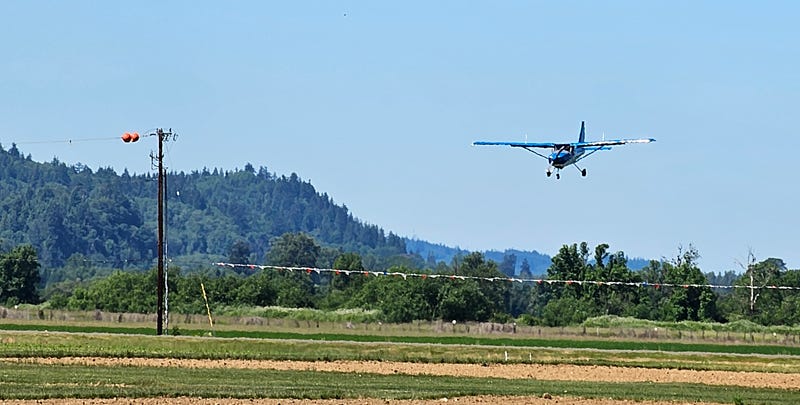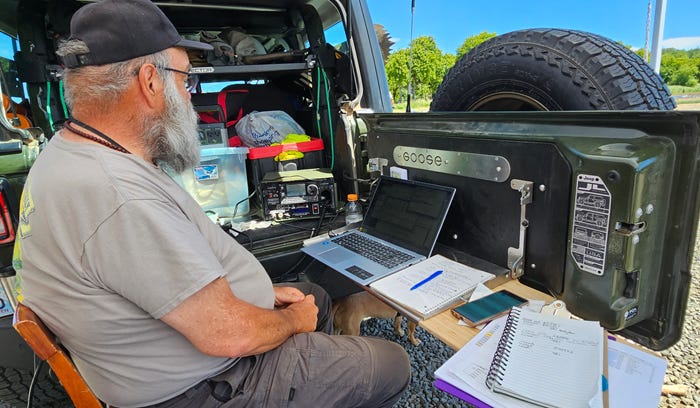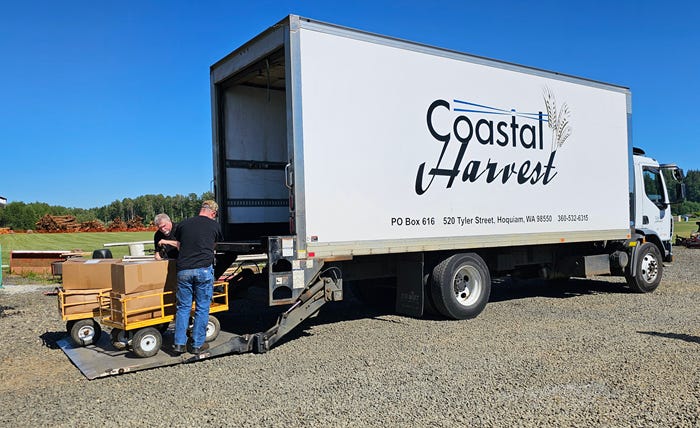
It was a perfect day for flying—clear skies and a light breeze—and Operation Thunder Run was in full swing. From Bellingham, WA, private planes were loaded with cartons of canned goods and flown to cities all over the state, simulating a civilian response to a major emergency.
My husband Randy and I were at one of the receiving ends—Chapman Farm, in Brady—watching those planes land, unload, and—sometimes—fly back and do it all over again. On the ground, temperatures were warm (finally!) and Chapman Farm bustled.
Friends and neighbors gathered for this event, chatting animatedly over hot coffee and hearty breakfasts of sausage, biscuits and gravy that got their mornings off to a good start. Pilots joined the group, swapping stories of previous flights and fly-ins, and commenting on the beauty of this part of the world. Everybody was smiling.
Off to one side, HAM radio operators from the Grays Harbor Amateur Radio Club worked out of a mobile setup, relying messages to the airfield at Bellingham. The most important was “We’re ready to receive.” Without that, the “Thunder Run” volunteer pilots would simply by-pass us in favor of other landing strips.
Why HAM radio rather than cell phone? Well, in truth, they used both. But in a disaster, these radio operators understand–often first-hand—that sometimes radio is the only way people can communicate during an emergency.

That, basically, was why Don and his wife Kim each got into HAM radio. As I recall the story, they were in the mountains and their vehicle slipped off the road into a ditch. They couldn’t get it out and—typical for remote areas—there was no cell service.
They had their mobile HAM radio equipment, however. So…they used it to contact a HAM operator in South Africa (yes, South Africa!) who relayed the call to a HAM operator in Europe (France, I think), who sent their call for help to a HAM operator in Florida, who contacted local authorities. They spent the night in their rig, but help arrived the next morning.
That’s a powerful testament both to the power of the HAM radio community and the basic goodness of people.
Japan has the most HAM radio operators in the world: 1.3 million
The US has the second most: nearly 700,000
So, why were private pilots flying in cartons of food, you may wonder? And why fly into a farm, when there’s a perfectly good airstrip (Bowerman Field) on the coast? Our population— 77,000 at last count—is composed (to a great extent) of farmers, fishermen, and loggers, aka resilient people.
Here’s why. The communities in our 1,901 square mile county are linked by bridges. Practically every winter a landslide closes a road for a few days somewhere in the county. Now imagine what would happen in the event of an 8.0 to 9.0 earthquake—the magnitude range expected when the Cascadia Subduction Zone rips open.
In that scenario, Bowerman Field would be underwater, and transportation between the county and major transportation corridors (I-5, in our case) would be impossible for weeks at least. During that time, no medicine, food, or fuel could be transported into the county by the usual means.
NOT Fun Fact
Cascadia Subduction events occur an average of every 246 years. The most recent event occurred in 1700. It’s overdue.)
In a major earthquake, many of the bridges in the county would collapse. Landslides would block roads. The land would sink an estimated six feet – nine in some places. The quake would trigger a major tsunami.
It’s not a pretty picture. That would happen up and down the Pacific coast, from northern California into southern Canada. (Check out the Surviving Cascadia webpage.)
You’ve seen the government response to Hurricane Helene in 2024. May I say it was lacking?
In North Carolina (and probably other states, as well) private, volunteer pilots provided a lifeline, flying in food and medicine while FEMA struggled.

Volunteers are the lifeblood of communities, in ways big and small. You may not notice them until they are needed. They may not even be local, but they see the bigger picture and are committed to doing what they can to help, even when it means flying a couple hours on days that, in a disaster, are far from perfect.
Operation Thunder Run is people helping people. At our best, it’s what we do.
Thanks for reading Where the Asphalt Ends! It’s free, delivered to your inbox weekly.






It's truly a privilege to get to work with communities such as yours and get a chance to support them. It's what we do, and it's a great honor.
As the county DART Coordinator, I'm very happy how supportive Chapman Farms was by hosting our exercise. I've reposted this on various FB pages.